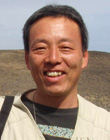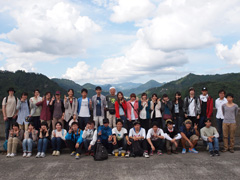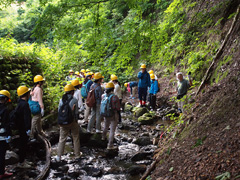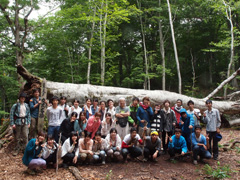Top>Education>Natural history education nurturing the future
 Index
Index

Harufumi Nishida [profile]
Natural history education nurturing the future
Harufumi Nishida
Professor of Plant Phylogeny and Evolution, Paleobotany, Faculty of Science and Engineering, Chuo University
Recording nature
Shizenshi is the Japanese translation of natural history. This is occasionally written as nature journal in Japanese, and there are many people who prefer it because it is closer to the original meaning. To put it simply, natural history is to describe everything in the natural world and pass it on eternally. Because the state of the natural world is described, there is a lack of credit as evidence only with words and illustrations. Therefore, we try to preserve as many specimens as possible. Electronic recording supplements the words and illustrations today, but no matter how high the resolution of a 3D image of an apple is, we should remember that it is a far cry from a specimen of a real thing.
There are not a few people who question why we take records and keep specimens, but the culture of posing those questions as a human being is more of a worry. Having an interest in all things in the natural world originates from curiosity, the basis of human intelligence, and leaving behind records is the inheritance and growth of intelligence, that is to say it is because a characteristic of human beings is that we are the only life form that can study from the past to learn new things. Apart from intelligence, since humans are originally animals, we cannot survive without paying attention to the surrounding nature. By adding intelligence, humans were able to place their own existence in nature through recording things. Prehistoric cavemen from all over the world have left behind many handprints as well as drawings of animals for hunting. There we can see the shape of ancient people who started to assert themselves through the use of their hands. Modern science and technology can be taken as one manifestation of the self assertion of humans. However, that type of self assertion in the present day, by expanding to a form exerting various pressure on the natural world, is inviting a situation where humans are signing their death warrant.
People responsible for sustainable development
Four major issues facing the human race since the end of the 20th century are population, food, energy, and environment. What these all have in common is that they are difficult to solve without taking their relation to living things into consideration. Furthermore, we should now add the issue of biodiversity to this list. Biodiversity issues are completely different from environmental issues. The environment is generally (especially in Japan) understood to be physicochemical changes seen to directly involve human lifestyle, with pollution and global warming being major examples. Also, there are many people who believe those kinds of physicochemical changes can be solved with technology, and along the same line of thought they believe that biodiversity problems can also be solved simply. Living things that form the basis of biodiversity constitute a complicated system containing levels and structures from atoms and molecules to ecosystems, and it can be said that there has not even been the slightest progress in clarifying that structure and behavior. Many people believe that rapid extinction of the most concerned species can soon be recovered by preserving their genes. However, if the genes are just a simple blueprint and there are no cells to act as a factory to make the genes work, a living creature will not be materialized. Furthermore, because a species consists of not a single individual but a group, in the case of animals, it is said that a species cannot survive unless there are at least 3,000 individuals.
All living creatures on earth as well as humans live in a symbiotic system that consists of production conducted by mainly photosynthetic organisms. On top of that, the balance between diverse ecosystems is greatly involved in the stability of the earth’s atmosphere and water cycle which directly affect biological production. In other words, before we have fears about the other four issues, if we do not first worry about the loss of biodiversity which human lifestyles and economic activities totally rely on, we cannot hope for sustainable development of the human race.
Biodiversity also tends to be a global issue for others to consider. However, because global biodiversity is an accumulation of regional biodiversity, that essence needs to be considered at a regional level. To promote regional understanding, it is necessary for all citizens to be aware of and responsible for protecting the living things and ecosystems around them. In future generations, it would be ideal to instill this kind of knowledge into each individual. What kind of education is necessary to achieve it?
Japanese natural history education
The Science Council of Japan has two committees related to biology field. They are the Basic Biology Committee which involves research related to the elucidation of life phenomenon and the application of that knowledge, and the Integrated Biology Committee which involves macroscopic biology that deals with life diversity information, ecosystems and evolution etc. The stance toward science in our country tends to favor the field conducted by the former committee and university education has been influenced by that, while trying to microscopically and reductively teach an understanding of nature and biology. For this reason there has been a dramatic drop in natural history science researchers belonging to the integrated biology field at universities, and naturally, there has been a decrease in comprehensive knowledge of natural phenomenon and places to teach a desirable outlook on nature based on that. This means that teachers involved in compulsory and high school education are also beginning to lack that kind of knowledge. I have fears about the expansion of this serious fault in the next generation’s view of nature.
Even in various crisis management situations in society, we are continuing to be painfully made aware of the loss of human resources who know the characteristics of nature well. One of the causes in a lack or delay of judgment in responding to disasters in recent years is thought to be the measuring of natural phenomena in figures and the blind belief that if digital predictions based on those results are followed, disasters can be averted. Natural phenomenon is a complex system and is essentially difficult to predict. Those kinds of predictions are conducted empirically by humans using their brains, the same kind of complex system that performs analog function, and analogical precautionary measures have been devised even at an individual level. Even though the so-called instinctive crisis management ability we have learned from nature has been tried in various circumstances, I especially feel that human capabilities have decreased these days. In order to avoid this kind of situation, I have the opinion that it is vitally important to experimentally teach the special characteristics of nature from compulsory education or earlier.
Natural history education in the Department of Biological Sciences



Photograph: Isamu Nikkuni
Since the inception of the Department of Biological Sciences in 2008, a two-night training camp called Natural History Outdoor Training is provided for second year students. Because some people are suited to outdoor activities and others are not, this is an optional course which is divided into a mountain course and sea course held in the summer holidays, and you can register for either. On average about 70-80% of students take the course. I am in charge of the mountain course and every year we visit Tadami Town in Fukushima Prefecture (photograph). Because it is a natural history training, you see various things. Tadami is a prominent area of heavy snowfall and you can observe the unique topography roughly carved into the face of the mountains by avalanches and a site where the formation of the earth from layers of igneous rock and sedimentary rock on top of the bedrocks of the Japanese archipelago can bee seen, as well as being able to collect fossilized plants from the middle Miocene (about 11 million years ago) while taking a dip in a mountain stream. The period of fossil was warmer than now and there was a completely different forest from the magnificent primeval beech (Fagus) forest we visit after the fossil collection. When trekking in the beech forest, we encounter various flora and fauna, and on the 2013 camp the students discovered a caterpillar fungus called Kamemushi-take (Cordyceps nutans). It is difficult to predict the weather in the mountains and the outdoor training is full of dangers. During a fossil collection in heavy rain accompanied by thunder, you can have a real experience of what dangers there are and how to avoid them. Sometimes you learn that you will be stung by a bee if you unconsciously swat it away.
In outdoor natural history education, you can restore the five senses which youths of late have been inclined to forget, experience ecosystems woven by the origins of nature and living things and their history, and learn that the complex natural phenomenon is unpredictable but possible to protect against. Also, frequently encountering situations difficult to handle is a perfect experience for constructing a code of conduct in society amongst ourselves.
Essentially, I want to open the course to new entrants fresh out of school. However, it is impossible because a drinking party, an important intellectual process in university society, I believe, is planned at night. So I set the course for 2nd-year students. I believe that the state where an extremely small number of students in the Department of Biological Sciences have experienced nature or the fact that they lost their student feeling as an adult who can control their drinking after entering university is a serious flaw brought about by the higher educational system which places priority on economic growth. On the final night before seeing the white roof of the Tokyo Dome again, we finish up with a customary barbecue. Here, we also have the valuable experience of making a fire with charcoal. While being surrounded in smoke, and if the unpredictable mountain weather is fine, the students gaze up to the majestic Milky Way and imagine themselves in space.
- Harufumi Nishida
Professor of Plant Phylogeny and Evolution, Paleobotany, Faculty of Science and Engineering, Chuo University - Born in Chiba in 1954. Graduated from the Graduate School of Science, Chiba University. Received his Doctorate from the Doctoral Program of the Graduate School of Science, Kyoto University in 1983. Became Professor in the Faculty of Science and Engineering (Biological Sciences), Chuo University in 1997. Visiting professor in the Department of Biological Science of the Graduate School of Science, the University of Tokyo. Also an affiliated member of the Science Council of Japan, a former representative of the Union of Japanese Societies for Natural History, and the Director-General of the Biodiversity Network Japan. His major fields of study include plant evolution and paleobotany (study of plant fossils). Conducted field investigation at the Antarctic Peninusla on New Year's Day in 2011.
- Research Activities as a Member of Research Fellowship for Young Scientists (DC1), Japan Society for the Promotion of Science (JSPS) Shuma Tsurumi
- Important Factors for Innovation in Payment Services Nobuhiko Sugiura
- Beyond the Concepts of Fellow Citizens and Foreigners— To Achieve SDGs Goal 10 “Reduce Inequality Within and Among Countries” Rika Lee
- Diary of Struggles in Cambodia Fumie Fukuoka
- How Can We Measure Learning Ability?
—Analysis of a Competency Self-Assessment Questionnaire— Yu Saito / Yoko Neha - The Making of the Movie Kirakira Megane








